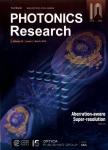Sensitivity of topological edge states in a non-Hermitian dimer chain
Sensitivity of topological edge states in a non-Hermitian dimer chain作者机构:MOE Key Laboratory of Advanced Micro-structured MaterialsSchool of Physics Sciences and EngineeringTongji UniversityShanghai 200092China
出 版 物:《Photonics Research》 (光子学研究(英文版))
年 卷 期:2021年第9卷第4期
页 面:574-582页
核心收录:
学科分类:07[理学] 070205[理学-凝聚态物理] 0702[理学-物理学]
基 金:National Key R&D Program of China(2016YFA0301101) National Natural Science Foundation of China(11774261,12004284,61621001) Natural Science Foundation of Shanghai(18JC1410900) China Postdoctoral Science Foundation(2019M661605,2019TQ0232) Shanghai Super Postdoctoral Incentive Program
主 题:structure. topological dimer
摘 要:Photonic topological edge states in one-dimensional dimer chains have long been thought to be robust to structural perturbations by mapping the topological Su–Schrieffer–Heeger model of a solid-state ***,the edge states at the two ends of a finite topological dimer chain will interact as a result of near-field *** leads to deviation from topological protection by the chiral symmetry from the exact zero energy,weakening the robustness of the topological edge *** the aid of non-Hermitian physics,the splitting frequencies of edge states can be degenerated again,with topological protection recovered by altering the gain or loss strength of the *** point of coalescence is known as the exceptional point(EP).The intriguing physical properties of EPs in topological structures give rise to many fascinating and counterintuitive *** this work,based on a finite non-Hermitian dimer chain composed of ultra-subwavelength resonators,we propose theoretically and verify experimentally that the sensitivity of topological edge states is greatly affected when the system passes through the *** the EP of a non-Hermitian dimer chain,we realize a new sensor that is sensitive to perturbation of on-site frequency at the end of the structure and yet topologically protected from internal perturbation of site-to-site *** demonstration of a non-Hermitian topological structure with an EP paves the way for the development of novel sensors that are not sensitive to internal manufacturing errors but are highly sensitive to changes in the external environment.



